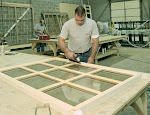Re-View often gets dragged into the debate on what is the proper scope of work for historic windows. It is often a heated subject that is vented out at tradeshows, meetings, and internet chat groups. As is the case with any good brawl, the emotions often run high from all constituents.
Anyone who has been involved in a project with historic fenestration has had to confront the question of what strategy to adopt concerning the windows. There are two opposing camps that best define this debate on historic windows. The following definitions of the window manufacturer and the tree hugger are done in the extreme for dramatic effect:
The Window Manufacturer: This group has one goal and that is to sell more windows. Profitability of the corporation and market share are paramount. As a rule, this group is more interested in increasing volume than doing what is right for the building. Attention to historic detail, performance, and quality are only considered if they are deemed contributory to the bottom line. The use of attractive photographs, slanted test results, and mass advertising has enabled this group to establish a strong influence.
The Tree Hugger: The biggest regret for this group is that they didn’t make it to the Woodstock concert back in 1969. They are extremely passionate about retaining historic fabric on a preservation project. All means, methods, and materials must be focused on restoring the window system back to its original form. Any deviation from that course is an abomination. Since this group is so fragmented and lacks the sex appeal or the marketing budgets of the manufacturers, they often remain the soft voice in the debate. If one listens to their common sense position on the subject, however, the message is very compelling and powerful.
So if you are an owner, architect, or general contractor how do you make sense of these diametrically opposed viewpoints concerning the subject? Do you replace your historic windows with new units, or do you restore every element back to its original state? The answer to that question depends on a number of factors such as the historic significance of the property, the use of the building, the budget, and the construction schedule. It also depends upon where the owner and architect land on the debate spectrum.
I am a firm believer that it helps to have input that is void of emotion to assist in determining an opinion on this subject. Unfortunately, there are few unbiased studies that exist on the topic. If you ask the manufacturers for data, they will produce internal test results that allege 74% energy savings with their products and claims of no future maintenance. If you ask the tree huggers, they will argue superior performance through complete restoration combined with a storm window and pull out the social responsibility card.
We have seen an independent study that is worthy of consideration. Robin E. Whitehurst and Susan Turner of Bailey Edward authored a study in 2009 that evaluated different treatments for windows at Lincoln Hall at the University of Illinois. The study compared replacing the windows with aluminum clad wood units, restoring the existing windows and retrofitting them with insulated glass, and adding a storm window to a repaired window.
The three courses of action were evaluated on energy performance, initial cost, maintenance costs, life cycle costs, and effects on the historic fabric. The study makes for good reading if you are wrestling with how to attend to historic windows on your project.
You can access the study through the following link:
http://www.illinoishistory.gov/ps/Lincoln%20Hall%20Window%20Life%20Cycle%20Study%202008%20%20Univ.%20of%20Illinois%20at%20Urbana%20Champaign.pdf
Tuesday, February 21, 2012
Subscribe to:
Posts (Atom)




